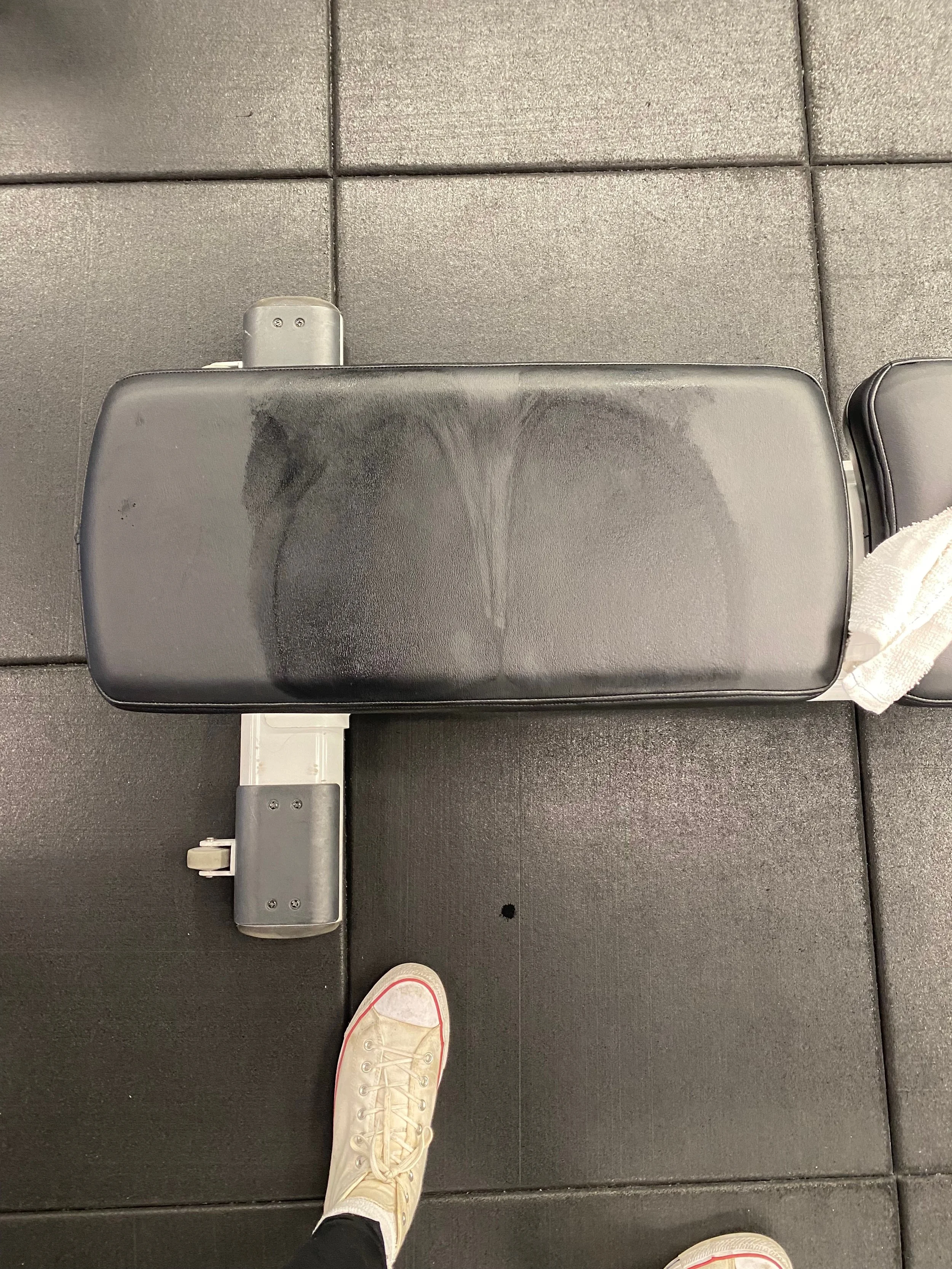Comfort, Fitness, and the Drive Toward Liberation
Last Sunday, a SoulCycle class shook me.
Not in the way a good workout should, with burning quads and a flushed face, but in the way a profound discomfort can rattle a carefully constructed sense of self. It brought me back to my very first entry on this blog, where I confessed that the lingering, physical reality of being a pre-op trans woman had stalled my fitness journey. I told myself I would wait for surgery to truly begin. That post resonated with so many, and it was cathartic to finally name that feeling. But it wasn't the whole story.
The deeper truth is that every act of growth is a confrontation with discomfort. This is a universal truth, a fact that cis and trans people alike must face in the process of transforming their lives. I’ve always prepared myself to encounter discomfort and sought out coaches to help me push past limits. Yet lately, with hypervisibility, limited social mobility, and active political persecution looming over our lives, the years of resilience I've built often fall short.
This meditation on comfort came into sharp focus when, in the middle of that class, I unclipped my shoes from the pedals and fled to the gender-neutral stall. My body had refused to participate any longer.
Fitness as a Hyper-Gendered Entry Point
Whenever I discuss these blogs with friends or fitness professionals, the same question emerges: How can I make my fitness space more comfortable for trans people, particularly trans women?
I'm still searching for a definitive answer, but my working theory is this: the integration of trans women into fitness spaces happens long before we ever set foot in the gym.
Before my workout even began, I had already spent significant mental energy on a single decision: what to wear. I showed up in opaque, solid-colored, high-waisted leggings; a thick-banded Tuckitupp gaff; a medium-impact sports bra; and a compression tank. This outfit was tight on tight—completely against my millennial fashion sensibilities—but it gave me armor for the hyper-gendered terrain of the studio. I knew that upon entry, my body would be evaluated. Despite being fully covered, I left no room for anyone to second-guess my She/Her™ status, even though I stood a full 7.5 inches taller than the average American woman.
This outfit symbolized something larger: my attempt to control other people’s perceptions and ensure “appropriate” gendering, a labor that transfeminine people disproportionately shoulder (Serano, 2007).
Discomfort Points of Contact
In the studio, discomfort stacked up quickly. Many of these “points of contact” would pass unnoticed to others, but carried heavy weight for me.
Check-in and shoe rental. SoulCycle requires shoe rental for their specialty bikes. I confidently requested a “size 12 men’s,” but the phrasing felt clunky and awkward. My friend, a gay man and the class trainer, gently suggested I ask for “size 47” next time, an act of subtle allyship that acknowledged the awkwardness without shaming me.
Mirror placement. My bike was positioned directly across from the mirror, which meant that both my reflection and half the room were visible. My immediate neighbor was a smaller-framed white woman, and our proximity made me hyper-aware of racialized and gendered differences. Besides my Black trainer, I was the only other Black person in the room. This brought into sharp relief how bodies are always already read through race and gender simultaneously (Collins, 2000; Snorton, 2017).
Socioeconomic access. This was a $25 class in the Castro, San Francisco’s historic gay district. Everyone in the room was solidly middle-class—an economic privilege I had through tech work. My participation was shaped not only by gender but also by race and class (hooks, 2000).
Even before the workout started, I was juggling multiple layers of visibility: my race, my gender, my height, my transness.
The Body in Pain
The class itself amplified these discomforts. The hard bike seat pressed directly against my tuck, pinching scrotal tissue within the gaff and magnifying pain. After 25 minutes, I unhooked myself and ran to the bathroom.
In the stall, I questioned myself: Why hadn’t I worn looser clothing? Later, reflection revealed the answer. A few days earlier, a neighbor had hurled the insult “manly” at me during a dispute over a parking spot. At the time, I brushed it off—bitch, look at the bodyyy. But subconsciously, I had shifted my fitness choices toward hyper-gendered, hyper-feminine attire in an attempt to reassert control. The SoulCycle outfit wasn't about pleasure; it was about armor.
This reminded me of Audre Lorde’s (1984) powerful writing on how women’s bodies are disciplined in ways that disconnect them from pleasure and power. For trans women, this disciplining is intensified, as our bodies are often treated as public property subject to constant evaluation and policing (Namaste, 2000).
The Social Cost of Comfort
This realization shook me. I’ve transitioned for over a decade, developed successful strategies for being gendered correctly, and gained access to spaces that many in my community still struggle to enter. And yet, even in a dark studio in the Castro, taught by my Black gay friend and surrounded by supposed community, I couldn’t show up untucked. I started to worry that maybe I had become the friend who is too woke. I’d spent years balancing engineering texts with race and gender studies, so maybe this conclusion was a long time coming. But really, the experience forced me to ask: Why can’t trans women show up to fitness classes untucked? Even in San Francisco?
At first, my instinct was to be smarter next time, to prepare better. But I've since reframed the question. What if, instead of being more prepared, I could be more liberated?
What if the next step in my fitness journey isn't about surviving discomfort, but about reimagining comfort itself—not as something trans women must constantly negotiate, but as something we are inherently entitled to in our pursuit of health?
On Tucking
Frankly, the way tucking is discussed online is often crass and deeply revealing of our culture’s biases. It's one of the newest iterations of how the American Protestant gender-essentialist paradigm has weaponized shameful narratives about genitals to subjugate transgender women.
Rooted in Protestant notions of bodily purity and discipline, our culture has long cast sexuality and non-reproductive embodiment as shameful. (Weber, 2002/1905; Foucault, 1990). This framework has produced a fixation on genitalia as markers of identity and moral value. In the case of trans women, it's been weaponized to frame our practices of self-fashioning as deviant or unnatural (Snorton, 2017). The tone of online discourse around tucking is not only disrespectful but also deeply revealing from a feminist and sociological perspective.
Part of this lies in the penis-centric narrative that dominates Western culture. In men, the penis is culturally associated with virility, hardness, and power. In contrast, the trans woman who tucks is imagined as forcibly restricting, folding, and contorting this supposedly sacred and symbolic organ (Freud, 1961; Lacan, 2006).
The act of concealment itself is often described in terms of desecration and harm, a framing that casts trans women as betrayers of masculinity. Julia Serano (2007) identifies this dynamic as transmisogyny: a form of oppression where trans women are simultaneously punished for embracing femininity and scorned as failed men.
While there are overlaps with broader misogyny—since cis women also endure genital-based shame—the stigma directed at trans women is compounded by the perception that they are "stepping down" from male privilege, encroaching upon "sacred" womanhood, and embodying queer perversity.
Interestingly, some of the most visible drivers of this shame are not cisgender heterosexual people but rather cisgender drag queens. Within drag culture, tucking is often presented as both painful and spectacular. RuPaul’s Drag Race exemplifies this dynamic and is primarily responsible for thrusting this practice into mainstream culture via Logo, MTV, VH1, and Peacock.
The famous “Makeover Challenge” repeatedly stages hyper-masculine men, often blue-collar, hairy, and burly, undergoing the supposedly extreme and uncomfortable process of tucking. These moments are shot in close-up, highlighting duct tape pulls and grimaces of discomfort. This spectacle recalls Judith Butler’s (1990) argument that drag both reveals and reinforces the performativity of gender, and Susan Sontag’s (1964) observation that camp humor thrives on exaggeration and spectacle. Yet, as Meredith Talusan (2018) and Raquel Willis (2019) argue, the laughter is not neutral: it perpetuates transmisogyny by turning trans women’s embodied realities into punchlines for mass entertainment. The very names and personas within drag culture—such as “Trinity the Tuck”—capitalize on this spectacle, signaling to audiences that what makes drag dazzling is its ability to transform a penis into a flat, vulva-like surface.
See, comfort is not just about fabric, mirrors, or bike seats. It is about whether society allows trans women to exist in fitness spaces without making our presence conditional on performance, concealment, or perfection. So, why can’t trans women show up untucked?
The national consciousness surrounding trans women's bodies and the act of tucking has created a new, and deeply problematic, public expectation. The general public, increasingly exposed to trans narratives through media, has become a silent audience, anticipating a flawless performance of gender. This expectation of "perfect" tucking, born from a mix of drag culture spectacle and a cisnormative understanding of femininity, turns a personal act of comfort or gender affirmation into a public duty. Our daily lives are thus transformed into a stage where we are constantly evaluated.
This scrutiny feels particularly acute in cities with a large and visible drag scene. In these environments, fashion choices that were once a source of physical and psychological respite—like A-line dresses, skater skirts, and tunic tops—are now viewed by some as a "lazy" failure to perform. Suddenly, EVERRRYBODY is doing a “groin” check when a doll enters the room. It’s fucked up, and we can tell you’re doing it! This judgment reduces trans women to a one-dimensional caricature, implying that our femininity is only valid if it is meticulously crafted and aggressively concealed. The subtle, everyday aesthetics of womanhood are dismissed in favor of a theatrical ideal.
For trans women who once sought the goal of blending in and living a quiet, assimilated life, these new expectations are a profound setback. The pressure to tuck 24/7 is now reinforced not just by a general societal gaze but by specific communities, including some heterosexual and homosexual men. This pressure to constantly "perform" for male validation is a form of transmisogyny that mirrors the patriarchal expectations placed on cis women, but with an added layer of scrutiny. It frames our bodies not as our own but as objects to be judged, and our gender not as an internal truth but as a performance that must satisfy an external, often male, audience. It reinforces the harmful idea that a trans woman's worth is tied to her ability to approximate a cisgender ideal, rather than being accepted in her own authentic form.
While more respectful conversations about tucking are happening, thanks to gender liberation movements, the marketing from even trans-owned brands still reveals subtle pressures. The very ads meant to empower often reinforce the same transmisogynistic ideals they claim to fight.
Tuck Kit's ads use vector illustrations to depict trans bodies, creating a sanitized, almost clinical, ideal that removes any real-world complexity or "messiness" associated with tucking. This graphic design choice offers a depersonalized, flawless body for a product that is, in reality, used to manage a complex and often uncomfortable body part.
TuckItUppp's campaigns predominantly feature post-operative trans women. This choice subtly suggests that the "ideal" body for their gaffs has already been surgically altered, which betrays the purchasing audience on the efficacy of the product.
Origami Customs' use of more nonbinary models assigned male at birth offers a strategic avoidance of pre-op trans bodies. By focusing on nonbinary bodies, including full beards and body hair, their campaigns sidestep the pressures of hyper-sexualization and the binary expectations of womanhood, offering a different narrative around tucking as a tool for personal comfort and gender expression with a “transgender-lite” marketing strategy.
This tension highlights how marketing, even when created with good intentions, can still be influenced by the same societal standards that create shame in the first place. On one side, Protestant-inflected purity culture and drag-based spectacle reinforce tucking as an emblem of deviance and shame. On the other, community-owned businesses and queer-led medical advocacy are working to redefine it as a legitimate and safe practice of gender expression.
Ultimately, this clash reveals how trans women's bodies are not just physical forms but sites of cultural and political contest, where we are fighting to reclaim our own narratives of dignity and autonomy.
See, comfort is not just about fabric, mirrors, or bike seats; it’s about whether society allows trans women to exist without making our presence conditional on performance, concealment, or perfection. I can’t say I’ll workout from now on without tucking or that it will be safe for anyone else to do so. But Until gender liberation is achieved, comfort will remain contested. each time I step into a class, I remind myself: liberation is not waiting at the finish line (sorry, Raquel). It is something I can begin to practice, even imperfectly, in the present.
📑 References
Collins, P. H. (2000). Black feminist thought: Knowledge, consciousness, and the politics of empowerment (2nd ed.). Routledge.
hooks, b. (2000). Feminism is for everybody: Passionate politics. South End Press.
Lorde, A. (1984). Uses of the erotic: The erotic as power. In Sister outsider: Essays and speeches (pp. 53–59). Crossing Press.
Namaste, V. (2000). Invisible lives: The erasure of transsexual and transgendered people. University of Chicago Press.
Serano, J. (2007). Whipping girl: A transsexual woman on sexism and the scapegoating of femininity. Seal Press.
Snorton, C. R. (2017). Black on both sides: A racial history of trans identity. University of Minnesota Press.
Spade, D. (2011). Normal life: Administrative violence, critical trans politics, and the limits of law. South End Press.
Butler, J. (1990). Gender trouble: Feminism and the subversion of identity. Routledge.
Callen-Lorde Community Health Center. (2017). Safer tucking. https://callen-lorde.org/tucking
Fenway Health. (2019). Binding and tucking: Gender-affirming health information. https://fenwayhealth.org
Foucault, M. (1990). The history of sexuality, Vol. 1: An introduction. Vintage.
Freud, S. (1961). The ego and the id. Norton.
Lacan, J. (2006). Écrits: The first complete edition in English (B. Fink, Trans.). Norton.
Sontag, S. (1964). Notes on camp. Partisan Review, 31(4), 515–530.
Talusan, M. (2018, March 16). The enduring transmisogyny of RuPaul’s Drag Race. Them. https://www.them.us/story/the-enduring-transmisogyny-of-rupauls-drag-race
Weber, M. (2002). The Protestant ethic and the "spirit" of capitalism. (T. Parsons, Trans.). Routledge. (Original work published 1905)
Willis, R. (2019, November 21). The future of trans liberation. Out Magazine. https://www.out.com/raquel-willis-trans-liberation
World Professional Association for Transgender Health. (2022). Standards of care for the health of transgender and gender diverse people, Version 8. International Journal of Transgender Health, 23(Suppl. 1), S1–S259




